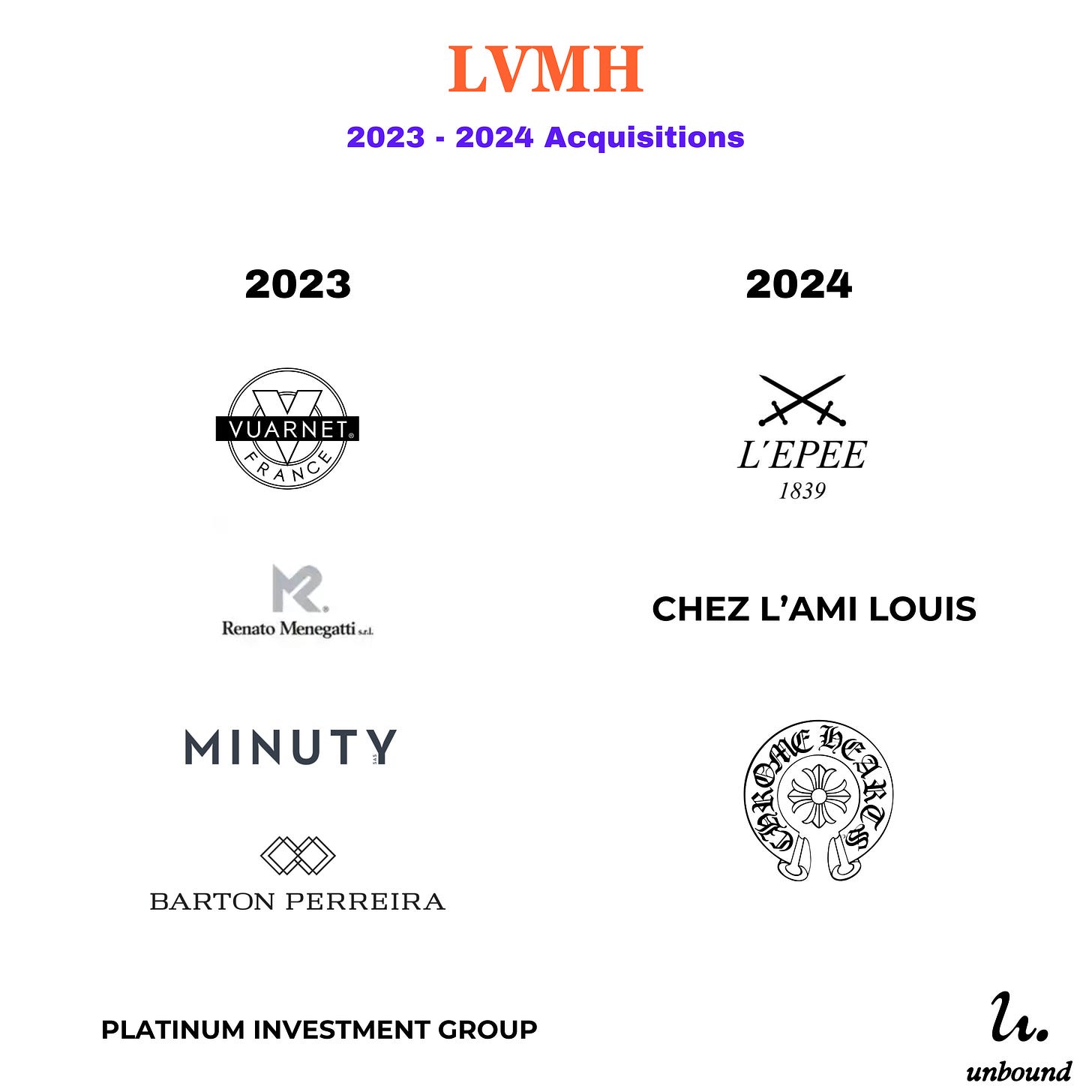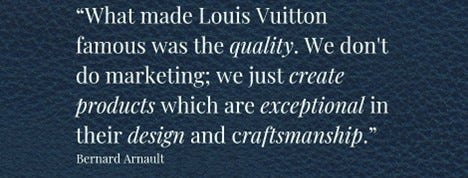We all know LVMH is the largest luxury empire.
And that it comprises more than 75 brands, and as of July 2024, its market capitalization is US$374 billion.
Image: Quartr
But what if I told you this is just part of their story?
What is this mighty universe really comprised of?
Let me share what I discovered about the less-known pillars of LVMH and why Bernard Arnault is not stopping and won’t stop fortifying his kingdom.
“As long as I’m not the richest man in the world, I won’t really be happy.”
Bernard Arnault, Founder, Chairman & CEO of LVMH
I. The Genesis: Acquiring Legacy and Heritage
Bernard Arnault's journey into luxury began in 1984 with the acquisition of Boussac Saint-Frères, which was owned by Christian Dior.
By 1987, he had orchestrated the merger of Louis Vuitton with Moët Hennessy, birthing LVMH.
Arnault's playbook? Aggressive acquisitions of high-end brands across various sectors. Focusing on:
Acquiring and developing strong heritage brands
Seeking "timeless and growing" brands adaptable to modern life
But what do all these brands have in common?
They are all highly reputable brands that command high consumer trust and are a strategic fit with the LVMH portfolio.
"Your brand power is the strongest possible determinant of your business health."
Warren Buffet
So, what superpower does owning a reputable brand give you?
"If you've got the power to raise prices without losing business to a competitor, you've got a very good business."
Warren Buffet
Nonetheless, price hikes have recently been heavily criticized in the luxury world.
LVMH’s latest acquisitions (see below) are a testament to their aim of continuing to diversify their portfolio across multiple categories.
Looking at these acquisitions got me thinking: why aren’t most of these brands easily recognizable if all its acquisitions are usually “Star Brands?
Let’s look further and see how it all ties together.
II. The Follow-through: Scaling Luxury Brands
LVMH's strategy to scale without sacrificing efficiency is evidenced by its impressive 26.5% operating margin for 2023.
They preserve brand identity while leveraging group resources, enabling a broad consumer appeal across various price points without brand cannibalization.
It’s a delicate balance that requires finesse.
Some strategies are apparent, but their success lies in their impeccable execution.
Brand Preservation & Enhancement: Maintaining and elevating brand DNA.
Operational Excellence: Optimizing supply chains and retail experiences.
Strategic Financial Management: Investing in growth while focusing on profitability.
Global Market Expansion: Entering new markets and exploring cross-brand synergies.
Innovation and Digital Transformation: Driving product innovation and enhancing digital presence.
Talent and Expertise Management: Retaining and integrating key talent.
Control and Long-Term Vision: Maintaining majority control for long-term brand building.
As LVMH continues to scale, one must wonder: how far can they push the boundaries of luxury without losing their essence?
III. Building a Luxury Ecosystem
These days, luxury consumers crave memorable experiences as much as they do material possessions.
LVMH recognized this trend early and strategically expanded into nearly every luxury lifestyle category imaginable—fashion, leather goods, wines and spirits, watches and jewelry, perfumes and cosmetics, and even hospitality.
To reinforce its brands' prestige and relevance in the modern luxury market, LVMH continuously innovates, delivering unique and immersive experiences that captivate and delight discerning customers.
Here’s their master plan, as I see it: living a luxurious life will soon mean relying on LVMH.
LVMH has woven itself into the very fabric of luxury living. But this isn't just about selling more products; it's a masterful strategy with layers of brilliance that often go unnoticed:
Create a 360-degree luxury lifestyle offering
Enable cross-selling opportunities
Increase share of wallet spent
Foster brand synergies
Diversify risk
Leverage brand equity
Use comprehensive customer data to target its customers better
Achieve economies of scale
Adapt to changing consumer preferences
LVMH must constantly balance growth and maintain the special mystique that makes luxury brands so desirable.
As the empire expands, I wonder: Where is the ceiling for LVMH's ambitions?
Part of their genius is subtlety.
LVMH orchestrates a symphony of opulence, guiding discerning consumers through a life of curated extravagance—often without consumers even realizing the vast web they’ve created.
The Personal Touch: LVMH Métiers d'Arts
Bernard Arnault understands that LVMH must excel at every stage of the fashion pipeline to maintain its position as the world's leading luxury company.
This insight led to the creation of LVMH Métiers d'Arts in 2015, a division dedicated to preserving and advancing exceptional craftsmanship and manufacturing expertise.
This is especially true when the fashion and leather goods segment remains LVMH's largest revenue generator, accounting for approximately half of the group's total revenue of €20.7 billion in Q124.
In an era dominated by discussions of AI and automation, commonly the true allure of LVMH's products lies in their handmade, exotic nature—a testament to the irreplaceable value of human touch.
This strategy not only safeguards the brand's heritage but also provides significant advantages for its brands, including:
Optimizes costs
Enhances brand prestige
Controls supply chain
Drives innovation and sustainability
Enriches brand storytelling
Retains & guarantees talent (+2700 apprentices trained)
Well, maybe in the past. Today, marketing is paramount for LVMH as of 2022, its spent was +US$22bn.
What is the strategy?
The same playbook: acquisitions and partnerships, but this time with specialized artisanal companies worldwide and highly reputable legacy operators in key supply chain niches.
They’re just getting started. Between 2023 - 2024, the following acquisitions were made.
LVMH's recent acquisitions are taking on new significance as the luxury giant faces mounting pressure to enhance transparency and ethical practices across its supply chain.
The company's vertical integration strategy is becoming increasingly crucial in light of recent controversies, particularly the investigation into alleged labor exploitation at Dior's subcontractors.
The Next Frontier: 22 Montaigne Entertainment
In a bold move, LVMH recently launched 22 Montaigne Entertainment. This new division isn’t just about shaking up brand storytelling; it’s about keeping LVMH’s brands at the forefront of cultural relevance.
LVMH is playing the long game, ensuring its brands remain culturally relevant for generations.
This is a crucial factor in an industry where let’s face it, only a few brands have managed to survive multiple generations.
The division's ambitious goals include:
Enhance marketing activities
Expand reach through captivating content
Generate new revenue streams
Position LVMH as a "creator of culture" and "house of stories
Optimize marketing costs
This venture isn't just about storytelling – it's a calculated move into the future of content creation.
LVMH is poised to leverage its market position to invest in, and partner with generative AI companies focused on content creation. This strategy aims to maintain relevance while significantly reducing costs.
Check out this insight from Jeffrey Katzenberg, the co-founder of DreamWorks:
“Artificial intelligence will lower the cost of creating blockbuster animated movies by around 90%. It took 500 artists five years to make a world-class animated movie in the good old days. I don’t think it will take 10% of those three years from now.”
LVMH's journey at the crossroads of luxury and technology is just beginning.
As the group continues to expand its empire, it's clear that the future of luxury lies in the delicate balance between artisanal heritage and cutting-edge innovation.
Stay tuned as we uncover how LVMH isn't merely adapting to technological shifts but is also driving innovation in the luxury sector.
Key LVMH Lessons for Those Building/Investing in the Sector 🔐:
Embrace vertical integration while maintaining brand autonomy.
Due to the complexity of the fashion industry, some challenges must be solved externally.
As a brand owner, it is crucial to emphasize brand heritage while embracing adaptability to new cultural norms.
Sustainability & ethical practices have become more and more relevant.
“Fashion is inspiration, creativity, and intuition. But it is also organization, strategy, and management. These two apparently contrasting sets of elements have come together to ensure the success of a business idea.”
Renzo Rosso, President & Founder, Diesel
Interesting Ventures to Watch 👁️:
FancyTech: Transform your ordinary product photos into dazzling videos with just a few clicks! Let AI add a touch of digital magic to create captivating content that will wow your customers and make your brand shine.
TheSeam: is like a fashion fairy godmother for your wardrobe! If you believe in sustainable style and cherishing your clothing, their network of skilled local artisans will make your fashion dreams come true.
BioFluff (previously Savian): Snuggle up in guilt-free luxury! This revolutionary plant-based fur is soft, stylish, and planet-friendly. Who knew saving the world could feel so cozy?
Quote of the Week
"Fashion is the important engine for visual culture. It's a documentary snapshot of our society at any given moment."
Ana Andjelic, The Sociology of Business
Jams of the week












